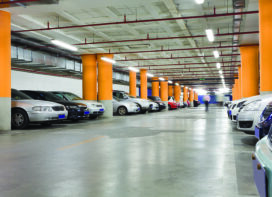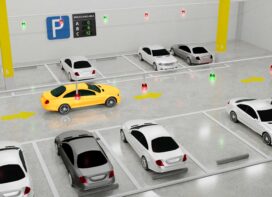
Dr Rasin Mufti

Dr Santosh Prasannan
The demand for parking spaces is high worldwide with an estimate of more than a billion spaces. However, due to increased economic activities and diminished land availability in many large cities, multistoried parking structures started to emerge.
Multi-storied parking structures started about 60 years ago and are generally classified under two categories – conventional and automated.
Automated parking structures are quite popular in Japan, South Korea, and Europe. There are nearly two million automated parking spaces available worldwide, however mostly are small, with only 30 structures having 300 spaces or more.

Conventional Parking
More than 95% of parking structures in GCC countries are conventional. They are owned and operated by various types of owners – government, semi government and private. A clear majority of conventional structures are made of reinforced or prestressed concrete. The design and construction of these structures are regulated by stringent local codes and design specifications. Majority of structure owners and users are familiar with the system and are comfortable with it.
However, in GCC countries, less than 5% of total multi-story parking structures are automated. Parking capacity ranges from 80 spaces to 1200 spaces per structure. The structural type is usually either all concrete or concrete shell with steel framing for the various floors.
Components of Automated Parking Structures

Automated Parking
Fully automatic parking structures consists of the three main components. The first is the transfer cabin or gate which serves as the entry or exit area for the cars. The cabin typically includes sensing devices and displays which provides detailed parking instructions to the users.
The second component is the automated storage and retrieval system. This generally consists of lifts, movable platforms for horizontal transfer of vehicles and a device (typically known as robot or satellite or dolly) to lift the car from storage to movable platforms.
The third component is the control systems consisting of a programmable logic controller (PLC) or machine control system, the parking control system (PCS) and the human machine interface (HMI).
Larger automated parking structures that exist in GCC countries fall under three systems. The first is a ‘Pallet – Based’ system which is used in several structures in Dubai. In this, a ‘pallet’ is used to transport car to and from its parking space. When entering the transfer cabin, the car is parked and positioned on a pallet and remains on the pallet when stored in the garage.
The second is a ‘Non-Pallet’ solution which is used in several structures in Dubai and Abu Dhabi. This system utilizes a device (known as robot or satellite or dolly) that can adjust to the length of the car’s wheelbase. The device drives under the car where the wheels are clamped and then transports the car onto the horizontal movable platform.
The third is the ‘Tower System’ which is used in several structures in Oman and Qatar. In this system, an elevator or series of elevators parks the car on either side on different levels in a tower structure.
Considerations in Selection of Parking Strategy
Several factors must be considered before deciding on the type of parking structure – conventional or automatic – in a project.
Type of land use and users
Generally, conventional parking structures are suitable for all types of users. On the other hand, automated parking is suitable for facilities with constant throughput volumes such as residences, retail, hospitals, train stations etc. They are not recommended for uses with high peak hour volumes such as stadiums, theaters etc.
 TrafficInfraTech Magazine Linking People Places & Progress
TrafficInfraTech Magazine Linking People Places & Progress


